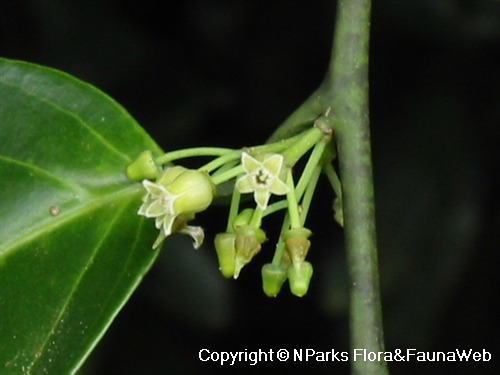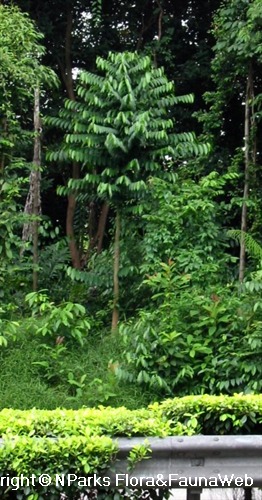
Name
Classifications and Characteristics
| Plant Division | Angiosperms (Flowering Seed Plants) (Dicotyledon) |
|---|---|
| Plant Growth Form | Tree (Big (>30m)) |
| Lifespan (in Singapore) | Perennial |
| Mode of Nutrition | Autotrophic |
| Plant Shape | Columnar, Irregular |
| Maximum Height | 40 m |
Biogeography
| Native Distribution | Myanmar, south Thailand, Sumatra, Peninsular Malaysia, Singapore, Borneo, and Java |
|---|---|
| Native Habitat | Terrestrial (Primary Rainforest, Secondary Rainforest) |
| Preferred Climate Zone | Tropical, Sub-Tropical / Monsoonal |
| Local Conservation Status | Native to Singapore (Vulnerable (VU)) |
Description and Ethnobotany
| Growth Form | It is a tree up to 40 m tall, with a dense and narrow crown. |
|---|---|
| Foliage | Its spirally arranged, stalked leaves have membranous to almost leathery leaf blades that are elliptic-oblong, 10–24 by 4–8 cm, and without translucent dots. The distal parts of the leaf stalks are also slightly swollen. |
| Flowers | Its long-stalked flowers are found singly or in 3–7-flowered, branched clusters from the leaf axils. They also have greenish-white petals. |
| Fruit | Its green fruits are smooth, egg-shaped, 2–3.5 by 1.5–2 cm, and crowned by the remains of the surviving outer flower parts. They also contain 1 seed that is surrounded by oily nutritive tissues. |
| Habitat | It grows in primary and secondary forests up to 600 m altitude. |
| Associated Fauna | Its flowers are insect-pollinated. Its fruits are eaten by mammals. |
| Cultivation | It can be propagated by seed. |
| Etymology | Greek strombos, conical or pear-shaped, referring to the shape of the fruit; Latin javanica, of Java, referring to one locality in the natural distribution of this species |
| Ethnobotanical Uses | Edible Plant Parts : Edible Leaves Food (Fruit or Vegetable): The leaves taste like groundnuts, and are eaten raw or cooked. Timber & Products: The plant produces timber that is used in general construction purposes, such as for building houses. |
Landscaping Features
| Landscaping | It is suitable for parks. |
|---|---|
| Desirable Plant Features | Ornamental Form |
| Landscape Uses | Parks & Gardens |
Fauna, Pollination and Dispersal
| Pollination Method(s) | Biotic (Fauna) |
|---|---|
| Seed or Spore Dispersal | Biotic (Fauna) |
Plant Care and Propagation
| Light Preference | Full Sun |
|---|---|
| Water Preference | Moderate Water |
| Plant Growth Rate | Moderate |
| Rootzone Tolerance | Moist Soils, Well-Drained Soils, Fertile Loamy Soils |
| Propagation Method | Seed |
Foliar
| Foliage Retention | Evergreen |
|---|---|
| Mature Foliage Colour(s) | Green |
| Mature Foliage Texture(s) | Leathery |
| Foliar Type | Simple / Unifoliate |
| Foliar Arrangement Along Stem | Alternate, Spiral |
| Foliar Attachment to Stem | Petiolate |
| Foliar Shape(s) | Non-Palm Foliage (Elliptical, Oblong) |
| Foliar Venation | Pinnate / Net |
| Foliar Margin | Entire |
| Leaf Area Index (LAI) for Green Plot Ratio | 3.0 (Tree - Intermediate Canopy) |
Floral (Angiosperm)
| Flower & Plant Sexuality | Bisexual Flowers |
| Flower Colour(s) | Green, White, Green - Light Green |
|---|---|
| Flower Grouping | Cluster / Inflorescence |
| Flower Location | Axillary |
| Flower Symmetry | Radial |
Fruit, Seed and Spore
| Mature Fruit Colour(s) | Green |
|---|---|
| Mature Fruit Texture(s) | Smooth |
| Fruit Classification | Simple Fruit |
| Fruit Type |
Image Repository
Others
| Master ID | 1855 |
|---|---|
| Species ID | 3148 |
| Flora Disclaimer | The information in this website has been compiled from reliable sources, such as reference works on medicinal plants. It is not a substitute for medical advice or treatment and NParks does not purport to provide any medical advice. Readers should always consult his/her physician before using or consuming a plant for medicinal purposes. |



.jpg)